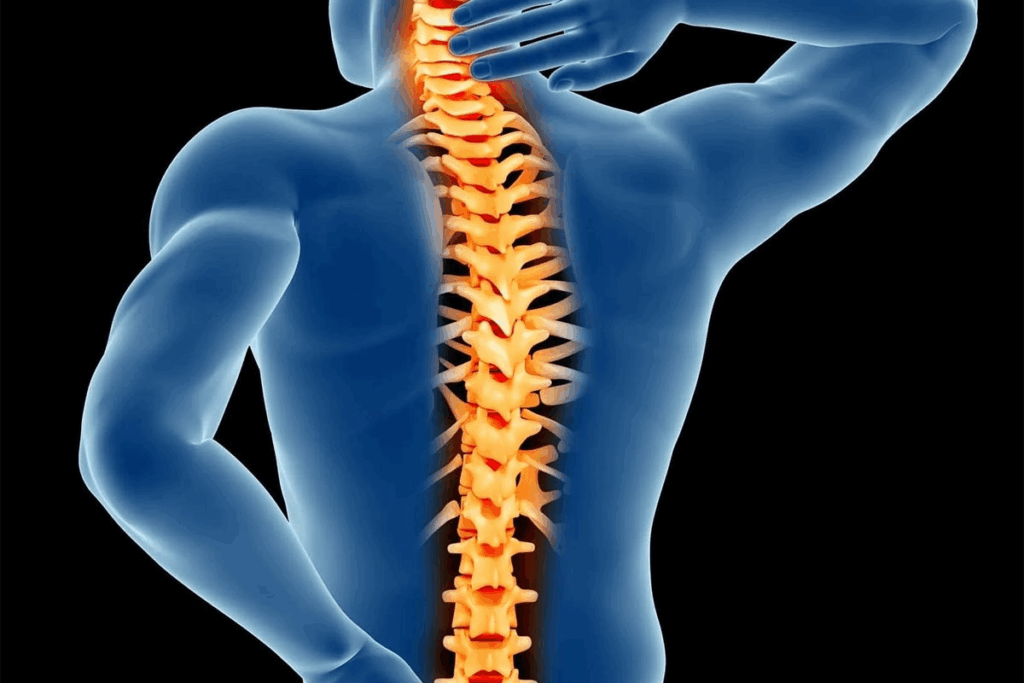
Facet joint injections are a common treatment for chronic neck and back pain. We inject a mix of anesthetic and anti-inflammatory medication into the facet joints. This helps patients with different spinal conditions find relief. Discover key facet injections neck side effects in the neck and lumbar regions for patient safety.
The facet joints are small stabilizing joints in the spine. They are between and behind adjacent vertebrae. They help with flexibility and movement while keeping the spine stable. At Liv Hospital, our experts focus on safe patient care. We want to tell you about the possible risks and side effects of facet joint injections.

Facet joint injections are a key treatment for pain from the facet joints. They are vital for managing chronic pain, mainly in the neck and lower back.
Facet joints are small joints between vertebrae. They help the spine move and stay stable. When these joints get inflamed, they can cause a lot of pain.
Facet joint injections use a mix of anesthetic and corticosteroid to reduce pain and inflammation. This treatment is chosen after other methods fail to help.
The procedure is done under imaging like fluoroscopy or CT scan. This ensures the medication goes to the right place. Here’s what happens:
The whole process takes less than 30 minutes. Patients are watched for a short time after to check for any immediate side effects.
| Procedure Step | Description |
| Patient Positioning | Patient is placed on an X-ray table, typically on their stomach or side. |
| Skin Preparation | The skin over the injection site is cleaned and numbed with a local anesthetic. |
| Needle Placement | A needle is inserted into the facet joint under imaging guidance. |
| Medication Administration | A mixture of anesthetic and corticosteroid is injected into the facet joint. |
Knowing about facet joint injections can ease worries and prepare patients. It helps them understand the treatment process and its role in pain management. This way, patients can make informed decisions about their care.

Understanding the side effects of facet injections for neck pain is key. These injections, or cervical facet injections, treat neck pain. They are safe but can cause side effects, some of which are listed below.
Facet injections in the neck often cause temporary pain or soreness at the site. This discomfort is usually mild and goes away in a few days. To ease this, try applying ice and taking over-the-counter pain relievers.
Some people might see swelling or bruising at the injection site. This is from the needle and the medicine. The swelling or bruising is minor and goes away in a week or two without treatment.
Numbness or tingling in the neck or nearby areas can happen after facet injections. These feelings are usually short-lived and come from the local anesthetic or steroid. They often go away as the body breaks down the medicine.
While these side effects can be worrying, they are usually not serious and don’t last long. But, if you have severe or lasting symptoms, reach out to your healthcare provider for help.
Thinking about lumbar facet injections for back pain? It’s key to know the possible side effects. These injections help with lower back pain from the facet joints. While safe, they can cause some side effects.
Patients might feel reactions at the injection site after a lumbar facet injection. These can include:
These reactions are usually mild and go away in a few days. Using ice and over-the-counter pain relievers can help.
Some people might feel temporary muscle weakness after the injection. This happens because the steroid can affect nearby muscles and nerves. The weakness usually goes away once the medication is absorbed.
Pain flare-ups are another side effect of lumbar facet injections. This is a temporary increase in pain at the injection site or in the lower back. Rest, ice, and gentle stretching can help manage these flare-ups. Most of the time, the pain goes back to normal in a few days.
Pain that gets worse after facet joint injections can be scary. But knowing why it happens can help. These injections aim to ease chronic pain, but some people might feel more pain right after.
Post-injection pain flares are a common side effect. They can happen for a few reasons, like the injection itself or the medicine used. The irritation from the needle or medicine can cause inflammation, making pain worse.
Managing expectations is key. Knowing these flares are usually short-term can ease worries. The severity and how long they last can differ from person to person.
The time pain lasts after facet joint injections varies. Usually, these pain spikes are brief, lasting from a few days to a couple of weeks. As the body gets used to the medicine and inflammation goes down, the pain often fades.
Keeping a pain diary is helpful. It lets you track your symptoms and helps doctors adjust your treatment plan if needed.
Dealing with pain that gets worse after facet joint injections requires both medical help and self-care. Over-the-counter pain meds can help. Sometimes, physical therapy or acupuncture is suggested too.
Rest and avoiding hard activities are important during recovery. Always follow your doctor’s advice for the best results.
Understanding and managing post-injection pain flares is key. If pain doesn’t get better or gets worse, seeing a doctor is important to check for any complications.
Cervical facet injections carry some risks. It’s important to know these risks before deciding. These injections are usually safe and help with neck pain. But, there are rare complications to be aware of.
One serious complication is vertebral artery damage. This can happen if the needle hits the artery by mistake. Symptoms include severe headaches, dizziness, and stroke-like symptoms.
Healthcare providers must use precise imaging to avoid this risk. Patients should watch for any unusual symptoms after the injection.
Nerve injury is another possible complication. It can occur if the needle touches a nerve or if the medication irritates nerves. Symptoms include numbness, tingling, or weakness in the arm or hand.
Most of the time, these symptoms go away on their own. But sometimes, they can last longer and need more medical help.
Spinal cord injury or irritation is very rare but possible. This can happen if the needle is too close to the spinal cord or if there’s a bad reaction to the medication.
Symptoms can range from mild tingling or numbness to severe loss of motor function. If symptoms occur, seek immediate medical help.
Knowing about these rare complications is key for those thinking about cervical facet injections. While the risks are low, being informed helps make better choices about care.
The lumbar facet injection procedure is generally safe but comes with serious risks. These injections aim to ease pain and inflammation in the lower back. Yet, there are risks tied to the procedure and the medications used.
Nerve root irritation is a possible side effect of lumbar facet injections. This happens when the medication or needle irritates nearby nerve roots. It can cause pain, numbness, or weakness in the lower back or legs.
In most cases, this irritation is temporary and goes away on its own. But sometimes, it may need more treatment.
Dural puncture is another serious risk. It happens when the needle accidentally hits the dura mater, the spinal cord’s protective membrane. This can cause cerebrospinal fluid (CSF) leakage.
CSF leakage can lead to severe headaches, nausea, and other symptoms. Though rare, it needs quick medical attention to avoid further problems.
Vascular complications are rare but can happen during lumbar facet injections. Injecting corticosteroids into a blood vessel can cause systemic side effects or damage to blood vessels. It’s important for the practitioner to use the right technique and imaging guidance to lower these risks.
To understand the risks and complications of lumbar facet injections better, let’s look at some key data:
| Complication | Frequency | Typical Symptoms |
| Nerve Root Irritation | Uncommon | Pain, numbness, or weakness in lower back or legs |
| Dural Puncture and CSF Leakage | Rare | Severe headaches, nausea |
| Vascular Complications | Rare | Systemic side effects, vascular damage symptoms |
Knowing these possible complications is key for patients thinking about lumbar facet injections. Being aware of the risks helps patients make informed decisions about their treatment. It also prepares them for any outcomes.
Steroid medication is a key part of facet joint injections. It can cause several systemic side effects. Knowing these effects is important, even if the injections help with pain.
Diabetic patients need to watch their blood sugar levels closely. Steroids can raise blood sugar by increasing glucose in the liver. They also make the body less sensitive to insulin. This can lead to higher blood sugar levels.
Facial flushing and hot flashes are common side effects. They happen because the steroids widen blood vessels. These symptoms usually go away on their own. But, if they don’t, tell your doctor.
Using steroid injections often can affect hormones. This can change how you feel and your body works. Talk to your doctor about how often you should get injections.
Knowing about these side effects is key for those thinking about facet joint injections. Being informed helps you make better choices. It also lets you work with your doctor to handle any side effects.
It’s important for patients to know the signs of infection after facet joint injections. Infections are rare, but knowing the symptoms can help get timely medical help. This can prevent serious problems.
Infection after facet joint injection can show in different ways. Common signs include:
These symptoms mean you might have a localized infection. It’s key to watch the injection site closely after the procedure.
If you notice any of these, get medical help right away:
Quick medical check-up can manage the infection and stop further problems.
Treatment for infections after facet joint injections usually includes:
It’s vital to finish all antibiotics as told and go to follow-up visits. This ensures the infection is fully cleared.
Allergic reactions and sensitivities to medication are risks with facet joint injections. These injections are usually safe, but knowing about possible side effects helps manage risks.
Some people may react to the medications in facet joint injections. Common symptoms include:
Telling your healthcare provider about any allergies before the procedure is key.
Contrast dye used in facet joint injections can cause reactions. These can range from mild to severe and include:
Those with a history of allergies or reactions to contrast dye should talk to their healthcare provider.
Healthcare providers take steps to avoid allergic reactions and sensitivities:
Patients can also help by:
Understanding the risks of allergic reactions and medication sensitivities helps patients with facet joint injections. Talking openly with healthcare providers and staying monitored can greatly reduce these risks.
Patients often wonder about the success rate and how long pain relief lasts after facet joint injections. We know this info is key for making treatment choices.
Studies show that facet joint injections work differently for the neck and lower back. Cervical facet joint injections help about 50-60% of patients. Lumbar facet joint injections help 45% to 60% of patients.
These numbers can change based on the patient group, what counts as “success,” and the injection method.
The time pain relief lasts after facet joint injections varies. People can feel relief for weeks to months. Here’s what some studies say:
But, relief times can differ for each person.
Many things can affect how well facet joint injections work. These include:
Talking to your healthcare provider about these factors can help you decide if facet joint injections are right for you.
Facet joint injections can help a lot with chronic neck and back pain. But, it’s important to know the possible side effects. These include facet joint injections side effects, facet injections neck side effects, and lumbar facet injection side effects.
We’ve looked at different side effects. These range from temporary pain and soreness at the injection site to serious issues like nerve injury and vascular problems. Patients need to think about these risks and the benefits of facet joint injections.
Patients should talk to their healthcare provider about their own risks and medical history. Knowing the side effects and benefits helps them make better choices. This way, they can manage their pain more effectively.
In the end, facet joint injections can be a good choice for chronic pain. But, understanding the risks is key to a successful treatment.
Facet joint injections help diagnose and treat neck and lower back pain. They involve injecting medication into the facet joints. These joints are small and located between and behind vertebrae in the spine.
Side effects of facet injections in the neck include temporary pain and soreness. You might also see swelling and bruising at the injection site. Numbness and tingling are common but usually mild and short-lived.
Lumbar facet injections can cause injection site reactions and temporary muscle weakness. You might also experience pain flare-ups after the procedure. These effects are usually mild and don’t last long.
Pain can worsen after facet joint injections due to post-injection pain flares. These can be caused by the injection process or the medication used. They usually last for a few days.
Cervical facet injections can lead to rare complications like vertebral artery damage and nerve injury. Spinal cord concerns are also possible. These can be serious and need immediate medical attention.
Lumbar facet procedures can cause nerve root irritation and dural puncture. Vascular complications are also possible. These can be serious and require immediate medical attention.
Steroid medication in facet joint injections can cause blood sugar elevation in diabetic patients. You might also experience facial flushing. Repeated treatments can have hormonal effects.
Signs of infection after facet joint injection include increasing pain and redness. Swelling, warmth, or pus at the injection site are also indicators. Fever, chills, or general malaise require immediate medical attention.
Yes, some people can be allergic to the medication used in facet joint injections. Common allergic reactions include rash, itching, swelling, or difficulty breathing. These require immediate medical attention.
The relief from facet joint injections can last several weeks to months. It depends on the condition, overall health, and lifestyle.
The success rate of facet joint injections varies. It ranges from 50% to 80% for both neck and lumbar injections, depending on the location and condition.
To manage worsened pain after facet joint injections, try applying ice or heat. Take over-the-counter pain relievers and rest. Gently move the affected area. Follow your healthcare provider’s specific instructions.
Subscribe to our e-newsletter to stay informed about the latest innovations in the world of health and exclusive offers!
WhatsApp us